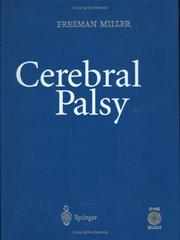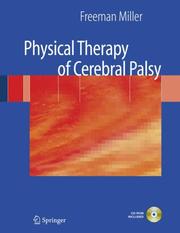| Listing 1 - 10 of 13 | << page >> |
Sort by
|

ISBN: 0387271244 0387204377 Year: 2005 Publisher: New York : Springer,
Abstract | Keywords | Export | Availability | Bookmark
 Loading...
Loading...Choose an application
- Reference Manager
- EndNote
- RefWorks (Direct export to RefWorks)
Cerebral palsy is a lifelong condition that affects the individual, family, and immediate community. Therefore, the goal of allowing the individual with cerebral palsy to live life with the least impact of the disability requires c- plex attention to the individual and the family. Furthermore, society needs to be sensitive and to accommodate individuals with disabilities by limiting architectural impediments and providing accessible public transportation and communication. The educational system provides the key means for helping the individual prepare to function in society to his or her maximum ability. In many ways, the medical care system probably has the least sign- icant role in preparing the child with cerebral palsy to function optimally in society. However, the medical care system is the place where parents first learn that their child has developmental issues outside the expected norm. It is almost universally the place where parents also expect the child to be made normal in our modern society. In earlier times, the parents would expect healing to possibly come from the doctor, but also they would place hope for healing in religion. As this belief in spiritual or miraculous healing has - creased, a significant font of hope has decreased for parents of young ch- dren with disabilities.
Cerebral palsied children --- Movement disorders in children. --- Cerebral palsy. --- Rehabilitation. --- Cerebral paralysis --- Little's disease --- Paralysis, Cerebral --- Brain damage --- Extrapyramidal disorders --- Developmental disabilities --- Paralysis, Spastic --- Pediatric neurology --- Orthopedics. --- Orthopedic surgery. --- Pediatrics. --- Conservative Orthopedics. --- Surgical Orthopedics. --- Rehabilitation Medicine. --- Paediatrics --- Pediatric medicine --- Medicine --- Children --- Operative orthopedics --- Orthopedics --- Surgery, Operative --- Orthopaedics --- Orthopedia --- Surgery --- Diseases --- Health and hygiene --- Rehabilitation medicine. --- Medicine, Rehabilitation --- Rehabilitation medicine --- Rehabilitation --- Medicine, Physical --- Children with cerebral palsy
Book
ISBN: 1280865377 9786610865376 0387383050 Year: 2007 Publisher: New York : Springer Science+Business Media, Inc.,
Abstract | Keywords | Export | Availability | Bookmark
 Loading...
Loading...Choose an application
- Reference Manager
- EndNote
- RefWorks (Direct export to RefWorks)
This well-crafted text discusses the theory and techniques used by physical and occupational therapists and is a derivative of Dr. Miller's highly regarded reference, Cerebral Palsy. The book is conveniently divided into two sections. The first focuses on fundamental aspects of cerebral palsy management, from understanding motor impairment to evaluating equipment use. The second section presents specific rehabilitation techniques, including neurodevelopment therapy, hippotherapy, and assistive devices. A wealth of tables, algorithms and detailed illustrations helps the reader with the decision-making process for determining what treatment would be most beneficial. With its thorough and clinically-oriented approach, physical therapists who care for cerebral palsy patients will find this book invaluable to their practice.
Cerebral palsied children --- Cerebral palsy --- Rehabilitation. --- Physical therapy. --- Cerebral paralysis --- Little's disease --- Paralysis, Cerebral --- Brain damage --- Extrapyramidal disorders --- Developmental disabilities --- Paralysis, Spastic --- Physiotherapy. --- Rehabilitation Medicine. --- Rehabilitation medicine. --- Medicine, Rehabilitation --- Rehabilitation medicine --- Rehabilitation --- Medicine, Physical --- Children with cerebral palsy
Book
ISBN: 3319745581 3319745573 Year: 2020 Publisher: Cham, Switzerland : Springer,
Abstract | Keywords | Export | Availability | Bookmark
 Loading...
Loading...Choose an application
- Reference Manager
- EndNote
- RefWorks (Direct export to RefWorks)
This new edition will grow to three volumes and significantly expand existing sections on medical management of children with cerebral palsy, research, education and therapies. The first volume will cover the cause of CP, the underlying pathology in the brain and the secondary pathologies in different tissues, such as muscle and bone. There are a fair number of controversies and new techniques, such as PET scans, that are getter attention to make earlier diagnosis. It is still not clear whether early diagnosis makes a long term difference. Epidemiology will also be discussed. The second volume will focus on general medical concerns related to CP on each of the medical specialties and the musculoskeletal section - which served as the main focus of the previous edition. This volume will be updated with an emphasis on gait disorders, spasticity, seizures and movement disorders. New research and techniques on the hip and spine areas will be added as well. The third and final volume will be an expanded and comprehensive resource on therapies. More detail on the latest outcome research and techniques will be provided along with sections on orthotics and novel treatments and techniques. This reference work will build on gaps within the first edition and continue to be the definitive guide for rehabilitation physicians, orthopedics, neurologists and therapists who treat children with CP .
Neurology . --- Pediatrics. --- Rehabilitation. --- Orthopedics. --- Occupational therapy. --- Neurology. --- Conservative Orthopedics. --- Surgical Orthopedics. --- Occupational Therapy. --- Activity programs, Therapeutic effect of --- Occupation therapy --- Work, Therapeutic effect of --- Medical rehabilitation --- Physical therapy --- Psychotherapy --- Therapeutics, Physiological --- Orthopaedics --- Orthopedia --- Surgery --- Paediatrics --- Pediatric medicine --- Medicine --- Children --- Nervous system --- Neuropsychiatry --- Diseases --- Health and hygiene --- Cerebral palsied children --- Children with cerebral palsy
Multi
ISBN: 9780387271248 Year: 2005 Publisher: New York, NY Springer Science+Business Media, Inc
Abstract | Keywords | Export | Availability | Bookmark
 Loading...
Loading...Choose an application
- Reference Manager
- EndNote
- RefWorks (Direct export to RefWorks)
Social policy and particular groups --- Physiotherapy. Alternative treatments --- Paediatrics --- Orthopaedics. Traumatology. Plastic surgery --- farmacologie --- pediatrie --- revalidatie --- orthopedie --- rehabilitatie --- sociale integratie
Book
Year: 2009 Publisher: Project Gutenberg
Abstract | Keywords | Export | Availability | Bookmark
 Loading...
Loading...Choose an application
- Reference Manager
- EndNote
- RefWorks (Direct export to RefWorks)
Book
Year: 2005 Publisher: Project Gutenberg
Abstract | Keywords | Export | Availability | Bookmark
 Loading...
Loading...Choose an application
- Reference Manager
- EndNote
- RefWorks (Direct export to RefWorks)
Book
Year: 2005 Publisher: Project Gutenberg
Abstract | Keywords | Export | Availability | Bookmark
 Loading...
Loading...Choose an application
- Reference Manager
- EndNote
- RefWorks (Direct export to RefWorks)
Book
Year: 2009 Publisher: Project Gutenberg
Abstract | Keywords | Export | Availability | Bookmark
 Loading...
Loading...Choose an application
- Reference Manager
- EndNote
- RefWorks (Direct export to RefWorks)

ISBN: 9780387383033 9780387383057 0387383034 Year: 2007 Publisher: New York Springer Science+Business Media, Inc.
Abstract | Keywords | Export | Availability | Bookmark
 Loading...
Loading...Choose an application
- Reference Manager
- EndNote
- RefWorks (Direct export to RefWorks)
This well-crafted text discusses the theory and techniques used by physical and occupational therapists and is a derivative of Dr. Miller's highly regarded reference, Cerebral Palsy. The book is conveniently divided into two sections. The first focuses on fundamental aspects of cerebral palsy management, from understanding motor impairment to evaluating equipment use. The second section presents specific rehabilitation techniques, including neurodevelopment therapy, hippotherapy, and assistive devices. A wealth of tables, algorithms and detailed illustrations helps the reader with the decision-making process for determining what treatment would be most beneficial. With its thorough and clinically-oriented approach, physical therapists who care for cerebral palsy patients will find this book invaluable to their practice.
Cerebral palsied children --- Cerebral palsy --- Rehabilitation. --- Physical therapy.
Book
ISBN: 9780387271248 Year: 2005 Publisher: New York NY Springer New York
Abstract | Keywords | Export | Availability | Bookmark
 Loading...
Loading...Choose an application
- Reference Manager
- EndNote
- RefWorks (Direct export to RefWorks)
Cerebral palsy is a lifelong condition that affects the individual, family, and immediate community. Therefore, the goal of allowing the individual with cerebral palsy to live life with the least impact of the disability requires c- plex attention to the individual and the family. Furthermore, society needs to be sensitive and to accommodate individuals with disabilities by limiting architectural impediments and providing accessible public transportation and communication. The educational system provides the key means for helping the individual prepare to function in society to his or her maximum ability. In many ways, the medical care system probably has the least sign- icant role in preparing the child with cerebral palsy to function optimally in society. However, the medical care system is the place where parents first learn that their child has developmental issues outside the expected norm. It is almost universally the place where parents also expect the child to be made normal in our modern society. In earlier times, the parents would expect healing to possibly come from the doctor, but also they would place hope for healing in religion. As this belief in spiritual or miraculous healing has - creased, a significant font of hope has decreased for parents of young ch- dren with disabilities.
Social policy and particular groups --- Physiotherapy. Alternative treatments --- Paediatrics --- Orthopaedics. Traumatology. Plastic surgery --- farmacologie --- pediatrie --- revalidatie --- orthopedie --- rehabilitatie --- sociale integratie
| Listing 1 - 10 of 13 | << page >> |
Sort by
|

 Search
Search Feedback
Feedback About UniCat
About UniCat  Help
Help News
News